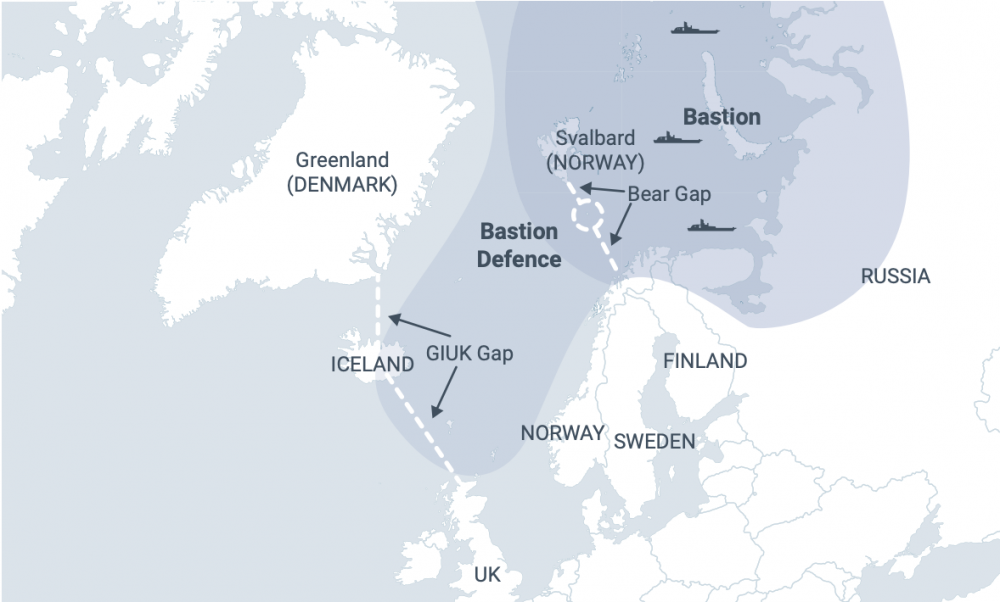In February 2022's Skulduggery: "Human activity' behind Svalbard cable disruption" we reposted a handy little map from the RAND Corporation:

The gaps are the areas that the Russian Arctic Fleet, and in particular the submarine forces, would have to traverse to get to: first, the Norwegian Sea and then the North Sea and: second, the open Atlantic Ocean. The Bear Gap is centered on Bear Island while the Greenland-Iceland-UK gap is centered on, well, you know.
The cable this story focuses on makes landfall in the Lofoten Islands, SSW of the Bear Gap.

From Bloomberg, July 11:
The destruction of an underwater monitoring system corresponded with inexplicable movements of a single fishing boat.
Norway has always relied on the sea. Fish long dominated the country’s diet, and in the 19th century the bloody harvest from Norwegian whalers provided much of the world’s lamp oil. Then came the discovery of an even more lucrative source of energy in the depths: massive petroleum and natural gas deposits in Norway’s sovereign waters, which turned it into the world’s most progressive petrostate. All of this has left the country with a great interest in understanding what happens off its famously wrinkled coast.
That’s why the Norwegian Institute of Marine Research exists. Headquartered in the city of Bergen on Norway’s southwestern coast, the government institute’s 1,100 employees monitor the health of the country’s salmon and cod stocks, measure the environmental impact of deep-sea drilling platforms and offshore wind farms, and chart how climate change is altering the northern oceans. One of its acoustic engineers, Guosong Zhang, works out of an office cluttered with cables and devices and computers of various vintages, or on one of the institute’s eight ships, spending weeks at a time at sea.
Born in Norway and educated in China, Zhang is brusquely matter-of-fact in a way that feels true to both cultures—in conversation, he doesn’t fill silences. Much of his work involves a set of five powerful microphones strung along a 31-mile cable on the floor of the Norwegian Sea called the Lofoten-Vesterålen Ocean Observatory. Known as LoVe to the researchers who run and maintain it, it’s mostly a scientific tool, but it’s also used by Norway’s military, which removes sensitive information before releasing the rest to the public. The government is vague about how it uses the data but acknowledges it could serve to identify specific ships in the area, whether those of Norway’s own military, its NATO allies or its adversaries. That also makes it an unorthodox part of the surveillance apparatus monitoring the increasingly provocative activities of Norway’s neighbor to the east, Russia.
The cable that carries the data from the microphones back to shore is a capillary in a global circulatory system. Hundreds of underwater communications cables circle the planet. Fiber optics jacketed in steel and plastic to protect against breakage and corrosion, they’re often barely an inch in diameter. They trace coastlines, traverse oceans and carry 99% of the world’s international data. They are at once vital and vulnerable.
In April 2021, Zhang was just back from Easter break when he noticed the LoVe observatory had gone quiet. It wasn’t unusual for the cable to have problems—the isolated northern region where it leaves the shore often has power outages. But when Zhang rebooted the computers remotely, there still wasn’t any data coming in. When he contacted technicians from the IT company that had installed the equipment, they didn’t have any luck either.
That meant the problem probably lay out at sea. Zhang hired engineering firms to do various tests of the cable’s electrical and optical systems; they eventually zeroed in on a segment some 17 miles offshore. It was just past one of the cable’s relay units, which serve to amplify the light pulses carrying information, ensuring the signal doesn’t die. Finding out more would mean getting access to the equipment itself, an expensive and time-consuming process requiring specialized ships and trained operators of submersible drones—both in short supply in the Arctic from the spring through early fall, when oil and gas companies take advantage of the sea ice thaw to repair their equipment, and when the institute’s own research vessels are booked for fish population surveys and other expeditions. So Zhang’s investigation stalled.
Finally, five months after the outage, Equinor ASA, Norway’s state-owned petroleum company and a partner on the observatory, informed the institute it would sponsor a mission to examine the cable. The company offered Zhang and his colleagues the use of the Havila Subsea, a 321-foot-long support vessel Equinor had chartered for an unrelated job.
Then the drone circled the cage, and Zhang had trouble believing what he saw. The output side should have been identical to the unit’s input side—the same machinery, the same cable extending north toward the next relay unit. But there was none of that. The equipment on that side had been ripped out, and the 12-ton section of cable attached to it was missing....On Sept. 10, the researchers gathered around a computer in Bergen, watching a live video feed from one of the drones—a boxy 8,000-pound robot measuring 6 feet by 6 feet by 10 feet with a pair of hermit-crab-like arms. As it descended, the glare of its lights caught krill jackknifing past its camera lens. The observatory’s yellow data cable soon emerged out of the blue-green haze, then the relay unit: a van-size metal cage, also yellow, protecting the equipment inside. At the approach of the submersible, fish that were sheltering inside the cage drifted lazily out.
*****...“It had been there for three years, and suddenly it’s gone,” he recalls. The cable hadn’t malfunctioned; it had disappeared. Someone, or something, had taken it....
....MUCH MORE